- Search:
-
- Quicklinks:
Instrumentation
- About BAF
- Instrumentation
- Sample Submission
- Services and Fees
- Policies and Guidelines
- Education and Resources
- Contact Us
Instrumentation
BAF has several instruments available for bioanalytical research.
Agilent 1290 Infinity II LC coupled to ABSciex QTRAP 6500+ with SelexION Differential
Mobility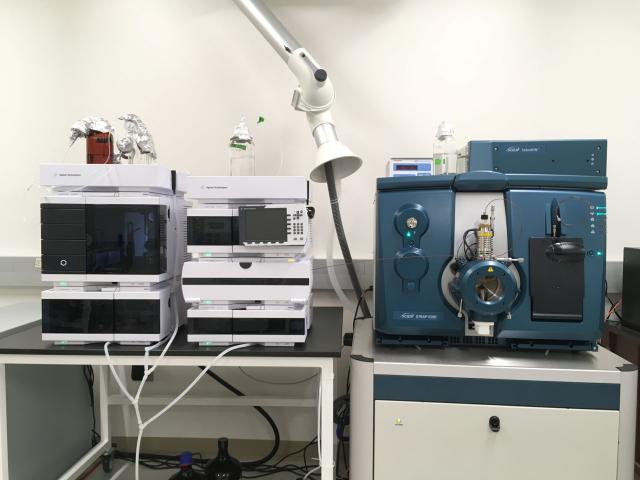
The liquid chromatography tandem mass spectrometry system (LC-MS/MS), depicted in
the picture, is composed of an Agilent 1290 Infinity II Ultra High Performance Liquid
Chromatography (on the left) which allows high-throughput separation of metabolites
based on their chemical properties. The ionization, detection, and quantification
of the compounds are carried by a benchtop hybrid triple Quadrupole-Linear Accelerator-trap
mass spectrometer.
The ABSciex QTRAP 6500+ mass spectrometer:
- Is highly sensitive with limits of quantification and detection in the order of femtomole even attomole when multiple reaction monitoring (MRM) is selected.
- Has a mass range of m/z 5-2000 and can switch from negative to positive ionization within five milliseconds allowing the detection and quantification of metabolites with different polarity in the same run.
- Is very versatile with a multitude of scan modes such as full scan MS, Product Ion Scan, Precursor Ion Scan, Neutral Loss Scan, MRM, MS3…
- Can perform two types of ionizations: Electropsray Ionization (ESI) and Atmospheric Pressure Chemical Ionization (APCI).
To complete this state-of-the art LC-MS/MS system a SelexION differential ion mobility (DMS) device is available to resolve metabolites with identical molecular weights, chromatographic retention times, and spectra. SelexION technology uses a very short planar cell that is located behind the curtain plate and upfront of the orifice of the mass spectrometer. Analyst software 1.7 is used to pilot the LC-MS/MS system and analyze data.
Agilent 1290 Infinity II LC coupled to ABSciex QTRAP 7500 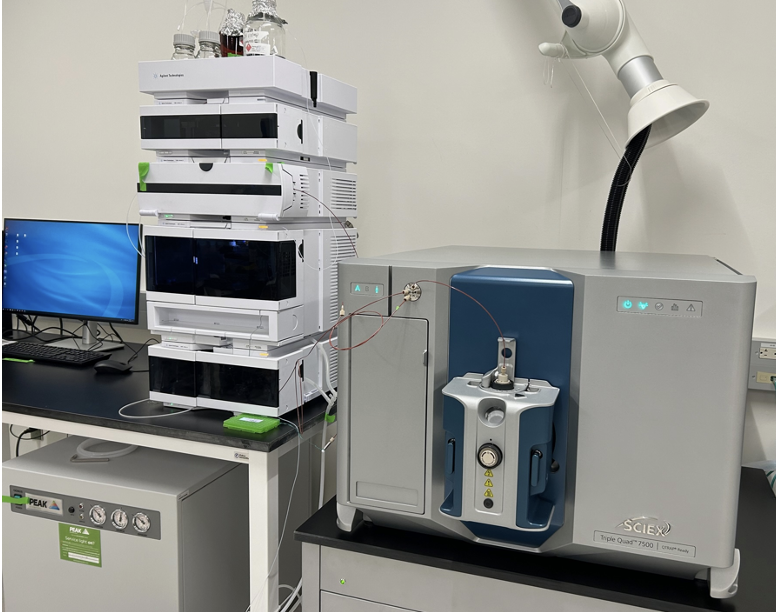
The liquid chromatography tandem mass spectrometry system (LC-MS/MS), depicted in
the picture, is composed of an Agilent 1290 Infinity II Ultra High Performance Liquid
Chromatography (on the left) which allows high-throughput separation of metabolites
based on their chemical properties. The ionization, detection, and quantification
of the compounds are carried by a benchtop hybrid triple Quadrupole-Linear Accelerator-trap
mass spectrometer. The ABSciex QTRAP 7500 mass spectrometer:
- Is highly sensitive with limits of quantification and detection in the order of femtomole even attomole when multiple reaction monitoring (MRM) is selected.
- Has a mass range of m/z 5-2000 and can switch from negative to positive ionization within five milliseconds allowing the detection and quantification of metabolites with different polarity in the same run.
- Is very versatile with a multitude of scan modes such as full scan MS, Product Ion Scan, Precursor Ion Scan, Neutral Loss Scan, MRM, MS3…
- Is a dedicated instrument for polar and non-polar lipid analyses.
AB Sciex Exion LC coupled to TripleTOF 6600+ with SelexION Differential Mobility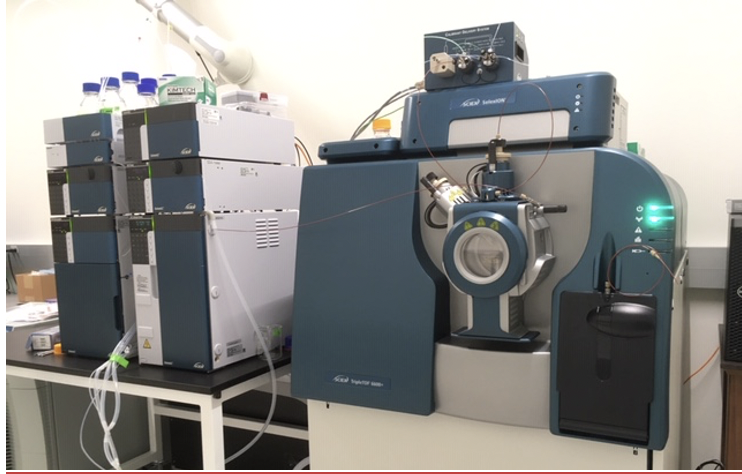
The liquid chromatography tandem mass spectrometry system (LC-MS/MS), depicted in
the picture, is composed of an ABSciex Exion Ultra High Performance Liquid Chromatography
(on the left) which allows high-throughput separation of metabolites based on their
chemical properties. The ionization, detection, and quantification of the compounds
are carried by an High Resolution triple Time of Flight mass spectrometer. The ABSciex
TripleTOF 6600+ mass spectrometer:
- Is equipped with a calibrant delivery system for seamless mass accuracy auto-calibrations during long sample runs
- Features MS/MS ALL with SWATH Acquisition, which enables collection of high-quality MS/MS spectra from all precursor ions across a user-defined mass range in a single injection
- Has a mass range of m/z 5-2250 amu
- Is dedicated instrument for untargeted metabolomics.
To complete this state-of-the art LC-MS/MS system a SelexION differential ion mobility (DMS) device is available to resolve metabolites with identical molecular weights, chromatographic retention times, and spectra. SelexION technology uses a very short planar cell that is located behind the curtain plate and upfront of the orifice of the mass spectrometer. SciexOS software is used to pilot the LC-MS/MS system and analyze data. Thermo Trace 1310
Gas Chromatography Coupled to an ISQ Single Quadrupole Mass Spectrometer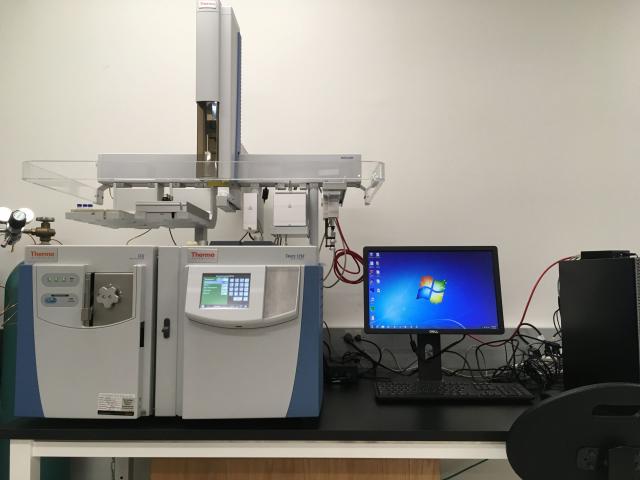
This instrument is used to analyze compounds (under 1100 amu) that are thermally stable
and have a boiling point below 300°C. Metabolites are ionized by Electron Ionization
(EI). The autosampler, a TriPlus TSH, permits online derivatization of samples. Possible
injections include: liquid phase, headspace and solid phase micro-extraction (SPME).
The identification of compounds is performed using NIST 17, a library containing over
300,000 mass spectra. Agilent 6890N Gas Chromatography coupled to 5975B MSD Single
Quadrupole Mass Spectrometer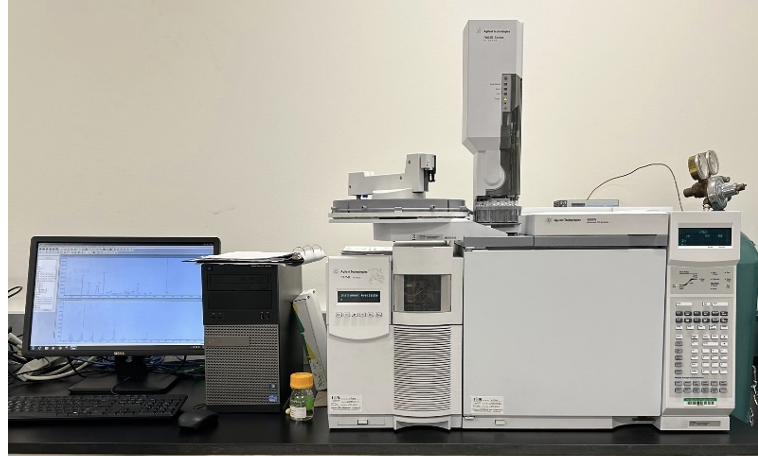
This instrument is used to analyze compounds (under 1100 amu) that are thermally stable
and have a boiling point below 300°C. Metabolites are ionized by Electron Ionization
(EI). The autosampler is specifically for liquid phase injections. This instrument
is dedicated to the analysis of fatty Technical notes
- Electrospray Ionization Theory
Electrospray Ionization (ESI) mode creates ions in solution. In the ESI mode, the liquid flow is forced through a stainless steel capillary where a high voltage (3-5 kV) and a nebulizing gas (Nitrogen) are applied. Small charged droplets are generated and undergo a process of solvent evaporation until ions leave the droplets in gas phase. Those ions enter the mass spectrometer to be detected under a specific scan mode. ESI is suitable for polar compounds such as amino acids and phosphorylated compounds.
- Atmospheric Pressure Chemical Ionization Theory
Atmospheric Pressure Chemical Ionization (APCI) mode creates ions at atmospheric pressure. In the APCI mode, the liquid flow is forced through a stainless steel capillary. Evaporation of both the analytes and mobile phase solvents occur under a heated nebulizer (note that no voltage is applied to the capillary). After nebulization, the analytes and mobile phase solvents are sprayed into a corona discharge needle. As a result, nitrogen is ionized first (most abundant in mobile phase), passes its charge to vaporized solvent, which transmits its charge to the analytes. Finally, ions enter the mass spectrometer to be detected under a specific scan mode. APCI is best suited for metabolites with low to medium polarities.
- Differential Ion Mobility Theory
After ESI or APCI ionization, ionized metabolites are pushed through a DMS cell (apparatus made of 2 parallel electrodes) using nitrogen as a carrier gas. The separation of the ions is achieved by alternating periods of: i) high voltage for a short amount of time, and ii) low voltage for a longer amount of time. This asymmetric waveform (separation voltage; SV) is continuously repeated across the DMS cell, which causes a drift of the metabolite towards one of the electrode. To compensate for this drift, a direct current voltage (compensation voltage; CoV) is applied to the electrodes in order to guide the ion of interest through the detector of the mass spectrometer. Additionally, chemical modifiers (acetone, isopropanol, acetonitrile, 1-propanol) can be used to enhance the resolving power of DMS.
Instrument Scheduling
Users are required to be trained by one BAF mass spectrometry personnel prior to accessing the mass spectrometer instrument(s). In order to be added to the Outlook calendar corresponding to the mass spectrometer instrument(s) of their choice, the users will receive an invitation by email from the facility's lab manager. At this point, users will be able to login and schedule a time slot on a specific device. Key card access to the facility will be given once the user's training is completed. Please, contact Brier Lee-Renken (Brier.Lee@unt.edu) for key card access, and Jean Christophe Cocuron (Jeanchristophe.Cocuron@unt.edu) for questions regarding mass spectrometer training.